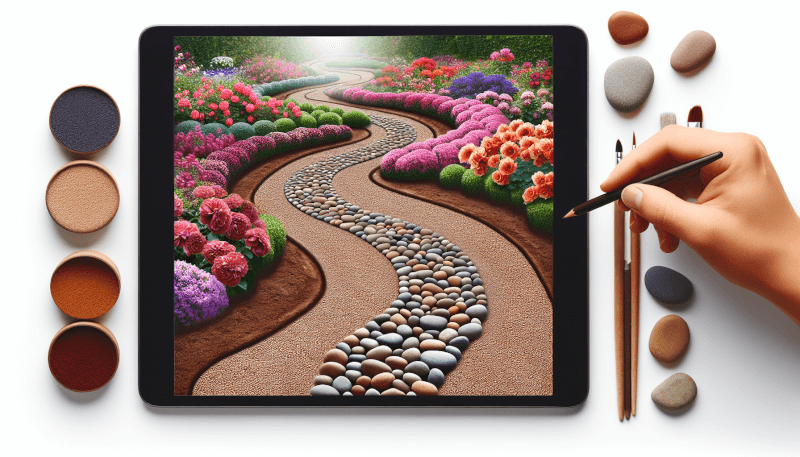You’re ready to transform your garden into a breathtaking paradise, and what better way to do so than by creating a stunning DIY garden pathway? A well-designed pathway not only adds beauty to your outdoor space but also provides functional access to various areas of your garden. In this article, we will explore the top ways you can create a remarkable pathway that will leave your guests speechless. So, grab your gardening gloves, put on your creativity hat, and get ready to turn your garden into a mesmerizing oasis with these simple yet effective tips and tricks.

Choosing the Right Materials
When it comes to creating a stunning DIY garden pathway, one of the first considerations is selecting the right materials. The material you choose will not only impact the overall aesthetic of your pathway but also its durability and longevity.
Picking the Right Type of Pathway Material
There are various types of materials to choose from when it comes to building a garden pathway. Some popular options include gravel, stone, brick, wood, and stepping stones. Each material has its own unique characteristics and advantages, so it’s important to consider your personal preferences and the style of your garden when making your selection.
Considering Durability and Longevity
Durability is a key factor to consider when choosing pathway materials. You want a material that can withstand foot traffic, weather conditions, and other environmental factors without deteriorating quickly. Additionally, considering the longevity of the material is important to ensure your pathway remains visually appealing for years to come.
Exploring Different Pathway Styles
Another aspect to consider when selecting materials is the style you want to achieve. Do you prefer a rustic, natural look or a more formal and elegant design? Each material lends itself to different styles, so take some time to explore different pathway styles and see which one resonates with your vision for your garden.
Preparing the Area
Before you begin creating your garden pathway, there are several important steps to take in order to properly prepare the area.
Clearing the Pathway Area
The first step in preparing the area is to clear away any existing vegetation or debris. Remove any plants, rocks, or other obstacles that may hinder the construction process. This will also provide a clean slate for your pathway design.
Removing Vegetation and Leveling the Ground
Once the pathway area is clear, it’s essential to remove any unwanted vegetation, such as grass or weeds. This can be done by manually pulling them out or using a garden tool like a hoe or shovel. Leveling the ground is also important to ensure a smooth and even pathway surface. Use a rake or a leveling tool to achieve a flat surface.
Marking the Pathway Layout
Before you start laying down materials, it’s helpful to mark the pathway layout. This can be done using stakes and string, or by simply outlining the pathway with spray paint. Having a clear visual representation of the pathway will guide you during the construction process and ensure that you achieve the desired shape and size.

Creating a Gravel Path
Gravel paths are a popular choice for garden pathways due to their affordability and versatility. Here are the steps to create a stunning gravel path in your garden:
Laying Weed Barrier Fabric
To prevent weeds from sprouting up through your gravel path, it’s recommended to lay down a weed barrier fabric. This fabric acts as a barrier, preventing weed growth while still allowing water to drain through.
Installing Edging for Containment
Edging is an important component of gravel paths as it helps to contain the gravel and prevent it from spreading into surrounding areas. You can use various materials like plastic, metal, or wood to create a defined border for your pathway.
Pouring and Spreading Gravel
Once the weed barrier fabric and edging are in place, it’s time to pour and spread the gravel. Start by pouring the gravel onto the pathway, then use a rake or shovel to evenly spread it out. Aim for a depth of around 2-3 inches of gravel for optimal functionality and visual appeal.
Building a Stone Path
Stone pathways add a touch of elegance and natural beauty to any garden. Here’s how you can create a stunning stone path on your own:
Excavating the Pathway
Start by excavating the pathway area to create a space for the stones. Remove the top layer of grass or soil until you reach a depth of around 4-6 inches. This will provide enough space for the stones to sit comfortably.
Laying a Base Layer of Sand
After excavation, it’s important to create a stable base for the stones. Spread a layer of sand over the excavated pathway and use a tamper or compactor to compact it down. This will create a solid foundation for the stones to rest upon.
Arranging and Setting the Stones
Once the base layer is in place, you can start arranging and setting the stones. Choose stones of various shapes and sizes to create an interesting and visually appealing pattern. Press each stone firmly into the sand, ensuring that they are level and secure. Use a rubber mallet or a wooden block to gently tap the stones into place if needed.

Constructing a Brick Path
Brick paths offer a classic and timeless look to your garden. Here’s how you can construct a beautiful brick pathway:
Preparing the Site
Before placing the bricks, ensure that the site is properly prepared. Clear the area of any obstacles and vegetation, level the ground, and mark the pathway layout.
Creating a Base for the Bricks
A stable base is essential for a durable and long-lasting brick path. Start by excavating the pathway area to a depth of about 6-8 inches. Fill the excavated area with gravel or crushed stone, then use a compactor to create a firm and level base.
Laying the Bricks in a Pattern
Once the base is prepared, you can start laying the bricks in the desired pattern. There are various laying patterns to choose from, such as herringbone, running bond, or basket weave. Lay each brick carefully, ensuring that they are level and evenly spaced. Use a rubber mallet and a level to adjust the position of the bricks if needed.
Designing a Wooden Walkway
Wooden walkways add a warm and inviting touch to any garden. Here’s how you can design a beautiful wooden walkway:
Digging Trenches for the Walkway
Start by digging trenches for the walkway, using a shovel or a trenching tool. The depth of the trenches will depend on the height of the wooden boards you are using. Aim for a depth that allows the boards to sit level with the ground.
Installing Landscape Fabric and Edging
To prevent weed growth and provide stability, it’s recommended to install landscape fabric in the trenches. Lay the fabric across the entire length of the pathway and secure it in place with landscape fabric pins. Install edging along the sides of the walkway to keep the boards in place and create a defined border.
Positioning and Securing the Wooden Boards
Once the fabric and edging are in place, it’s time to position the wooden boards. Lay each board tightly against the previous one, ensuring that they are level and aligned. Secure the boards to the ground by driving galvanized nails or screws through each board and into the ground below.

Planting a Stepping Stone Path
Stepping stone paths offer a whimsical and natural look and can be easily customized to suit your garden style. Here’s how you can create a stunning stepping stone path:
Choosing the Right Stepping Stones and Plants
The first step is to choose the perfect stepping stones for your path. Consider the size, shape, and color of the stones, ensuring that they complement the overall aesthetic of your garden. Additionally, select suitable plants or groundcover to plant around the stepping stones for added beauty and texture.
Arranging a Layout for the Stepping Stones
Before placing the stones, arrange them in the desired pattern to create a visually appealing layout. Play around with different arrangements until you find the one that best suits your garden style and preferences. Once you’re satisfied with the layout, mark the positions of the stones using stakes or spray paint.
Planting Flowers or Groundcover around the Stepping Stones
To enhance the beauty of your stepping stone path, consider planting colorful flowers or groundcover around the stones. Choose plants that thrive in your climate and provide a lush and vibrant look. Ensure that the plants are spaced appropriately to leave enough room for the stones and allow for easy access along the path.
Decorating with Mosaic Tiles
Mosaic tiles can add a unique and artistic touch to your garden pathway. Here’s how you can incorporate mosaic tiles into your pathway design:
Selecting Mosaic Tiles and Design
Start by selecting the mosaic tiles that best suit your style and preferences. There are countless options available, from colorful patterns to intricate designs. Consider the overall theme and color scheme of your garden to ensure a cohesive look. Sketch out a design or pattern for the mosaic tiles before you begin the installation process.
Preparing the Pathway Surface
Before applying the mosaic tiles, it’s important to prepare the pathway surface. Ensure that the area is clean, smooth, and free of debris. If needed, use a mild detergent and water solution to clean the surface, then allow it to dry completely before moving on to the next step.
Applying and Grouting the Mosaic Tiles
To apply the mosaic tiles, use a strong adhesive specifically designed for outdoor use. Apply the adhesive evenly to the pathway surface, then carefully place the mosaic tiles according to your design. Press each tile firmly to ensure a strong bond. Once the tiles are in place, allow the adhesive to dry completely before grouting. Apply grout between the tiles to fill in the gaps and create a seamless look. Remove any excess grout with a damp sponge, then allow it to dry according to the manufacturer’s instructions.

Adding Lighting Effects
Adding lighting effects to your garden pathway can create a magical ambiance and allow for safe navigation during the evening hours. Here are a few ways to incorporate lighting into your pathway:
Considering Solar-powered Path Lights
Solar-powered path lights are a popular and environmentally friendly option for lighting up your garden pathway. These lights harness the power of the sun during the day and automatically illuminate the pathway at night. They come in various styles and designs, allowing you to choose the ones that best fit your garden aesthetic.
Installing LED Strip Lights Underneath the Pathway
For a more modern and contemporary look, consider installing LED strip lights underneath the pathway. These lights provide a soft and subtle glow that highlights the edges of the pathway. LED strip lights are energy-efficient, long-lasting, and can be easily customized to fit the length of your pathway.
Using Lanterns or String Lights to Illuminate the Path
If you prefer a romantic and whimsical atmosphere, lanterns or string lights can be a beautiful addition to your garden pathway. Hang lanterns or string lights along the edges of the pathway or suspend them from trees or trellises. This will create a warm and enchanting glow that enhances the overall ambiance of your garden.
Maintaining Your Pathway
Once your stunning garden pathway is complete, it’s important to maintain it properly to ensure its longevity and visual appeal.
Regular Cleaning and Removal of Debris
Regular cleaning is essential to keep your pathway looking its best. Sweep away debris, leaves, and dirt regularly to prevent them from accumulating and causing damage. Use a garden hose or a pressure washer to wash away any stubborn stains or dirt buildup.
Repairing and Replacing Damaged Pathway Materials
Over time, pathway materials may become damaged or worn out. It’s important to inspect your pathway periodically and repair any cracks, loose stones, or damaged boards. Replace any irreparable materials to maintain the structural integrity and visual appeal of your pathway.
Updating the Pathway with Seasonal Decorations
To keep your garden pathway fresh and inviting, consider updating it with seasonal decorations. Add potted plants, seasonal flowers, or decorative elements that reflect the time of year. This will bring new life to your pathway and create a constantly changing display of beauty in your garden.


